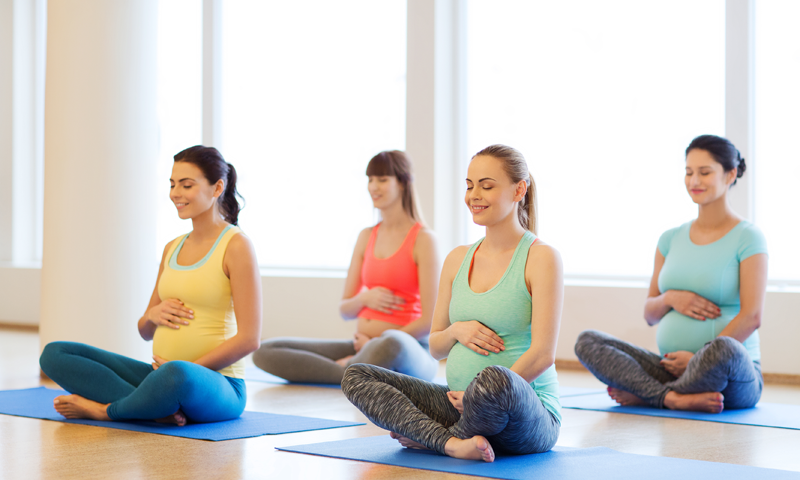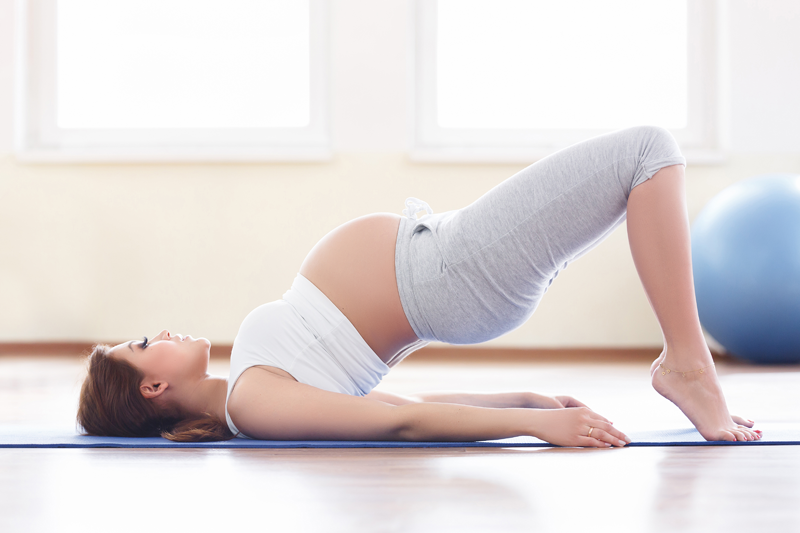
How Does Yoga Help You Stay Young?
8th August 2019
The Best Yogis on Instagram
15th August 2019Yoga Poses to Avoid When Pregnant

Prenatal yoga classes have a number of benefits including a lower incidence of prenatal disorders, low birth weight babies, and lower pain and stress. Obviously, a prenatal yoga class will be specially constructed to suit pregnant women; ordinary yoga classes, however, are not. With this in mind, it’s important to know which yoga poses to avoid when pregnant. In this article, we explore which yoga poses you should steer clear of and how to modify them to suit your condition. If you’re hoping to use yoga throughout your pregnancy, be sure to pick up a supportive yoga bra before beginning.
Revolved Side Angle Pose
Beyond the first trimester, or as soon as you see a bump, you want to stop doing poses that require you to twist along the waist. Unfortunately, that includes Revolved Side Angle Pose. As your baby is trying to grow in your stomach, you don’t want to cramp the space by twisting and turning unnecessarily.
Modification: Supported Side Angle
Instead of practising Revolved Side Angle, modify the pose to Supported Side Angle. Instead of twisting along the midline, this posture opens up one side of the body. To practice the pose, begin in Warrior II with your right knee bent. Next, bring your right elbow down to your right knee and inhale as you lift your left arm towards the ceiling. As you exhale, move the arm over your ear to make a straight line with the left side of your body. You are in Supported Side Angle. Hold the posture for around 30 seconds before repeating on the other side.
Wheel Pose
If you’re used to Wheel Pose, it isn’t completely off-limits during pregnancy. However, if you’re not comfortable with the pose or you’d rather avoid it, you can modify the posture to Bridge Pose, instead. Even if you are confident with Wheel Pose, it’s not recommended to practice it after 25 weeks.
Modification: Bridge Pose
If you don’t feel comfortable practising the full Wheel Pose, modify the asana to Bridge Pose. To practice the asana, start by laying on your back with your knees bent and the soles of your feet on the mat. Relax your arms and let them drop carefully to the sides of your body. Tuck your chin into your chest then lift your buttocks and back off the floor to create a bridge. You are in Bridge Pose. Hold for 15 seconds before lowering your back and buttocks back down to the ground.
Bow Pose
After the first trimester, it’s best to avoid laying on your stomach. Unfortunately, this means you’ll need to avoid any postures on your stomach. When your class is practising Bow Pose, consider modifying it and practising Camel Pose, instead.
Modification: Camel Pose
To practice Camel Pose, begin kneeling with the tops of your feet on the mat. Lift your chest and lengthen your neck as you use your stomach muscles to erect your body. Place your hands on your bottom, keeping some pressure there to remind you to stretch through your spine. Next, lower your head back while opening your chest, stomach, and quadriceps. You are now in Camel Pose. Hold the posture for around 30 seconds whilst breathing deeply.

Upward Facing Dog
In early pregnancy, Upward-Facing Dog is usually fine. However, as your stomach gets bigger it may become difficult to keep your pelvis raised. You may also find the size of your bump gets in the way during the asana. Thankfully, this can be easily modifying with the use of yoga blocks.
Modification: Upward Facing Dog on Blocks
To stop your stomach from hitting the ground, perform the asana on blocks. To practice Upward Facing Dog on Blocks, start by kneeling on your mat with two yoga blocks in front of you. Lean forward and place your hands on the blocks before moving your legs back until the tops of your feet are on the mat. Press your hands firmly into the blocks to keep your head and shoulders lifted, then press the tops of your feet into the ground to raise your quads. Finally, gaze forward and keep your neck neutral. You are in Upward Facing Dog on Blocks. Hold the asana for 30 seconds before coming out of the pose.
Forward Fold
It’s pretty obvious that you’ll need to avoid a full forward fold during pregnancy. Thankfully, this pose can be easily modified by spreading your legs.
Modification: Wide-Legged Straddle
To practice Wide-Legged Straddle, sit down on your mat with your legs apart. Once you’re comfortable, spread your legs as wide as possible. Keeping your knees straight and toes pointing towards the ceiling, place your hands out in front of you. Next, slowly lower your upper body towards the mat. If necessary, rest your hands on the floor for support. Finally, ensure that your back is straight. You are now in Wide-Legged Straddle. Hold the asana for around 15 seconds before releasing the stretch and repeating the process.
Twisted Chair Pose
As mentioned earlier, it’s best to avoid twisting at the midline after the first trimester. If your class is practising Twisted Chair Pose, you can still reap the benefits by modifying it to regular Chair Pose, instead.
Modification: Regular Chair Pose
To practice regular Chair Pose, stand tall with your big toes touching. Take a deep breathe in and raise your arms above your head and point your fingertips toward the ceiling. Draw both your shoulders back as you lengthen your neck. As you exhale, bend your knees and begin to lower your bottom down and back, much like you would when sitting on a chair. At this stage, it’s important to not let your knees extend past your toes. Each time you inhale, lengthen your spine a little more. With each exhale, deepen the stretch by lowering your bottom further toward the floor. You are in Chair Pose. Hold the posture for 30 seconds whilst breathing deeply.
In Summary
Providing that you take note of the yoga poses to avoid when pregnant, yoga can provide a number of great benefits throughout your pregnancy. In the colder months, remember to wear a cosy yoga hoodie to and from your class to keep your muscles warm and supple. This way, you can reap the most benefit from your class as you stretch deeply into each pose.

